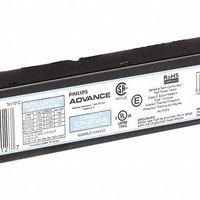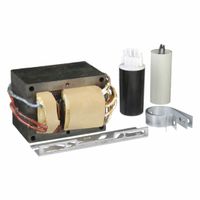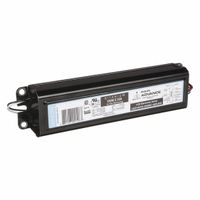Call +(254) 703 030 000 / 751 483 999 / 721 704 777
.....Read More
Frequently Asked Questions
What is the difference between a ballast and a driver?
A ballast is an electrical component used with fluorescent and HID (High-Intensity Discharge) lamps to regulate the current flow. These older lighting technologies require a specific voltage to ignite the gas inside the lamp and then a controlled current to maintain the arc. Without a ballast, the lamp would draw an increasing amount of current, leading to self-destruction.
A driver, on the other hand, is an electrical component used with LED (Light Emitting Diode) lighting. LEDs are current-driven devices, meaning their brightness and lifespan are directly related to the current flowing through them. An LED driver converts the incoming AC (alternating current) power to DC (direct current) and regulates the current and voltage to the LED array, ensuring optimal performance, efficiency, and longevity. Unlike ballasts, which often produce audible hums and generate heat, drivers are generally more efficient and quieter.
In essence, while both ballasts and drivers regulate electrical current for lighting, they do so for different types of lamps and employ distinct mechanisms to achieve that regulation. Ballasts are for gas-discharge lamps, while drivers are for solid-state LED lighting.
How do I know if my ballast or driver is bad?
If your fluorescent or LED light fixture isn't working correctly, a faulty ballast (for fluorescent lights) or driver (for LED lights) could be the culprit.
Signs of a bad fluorescent ballast include: * **Flickering lights:** The light may repeatedly turn on and off or flicker continuously.
* **Buzzing noise:** A loud, persistent buzzing sound coming from the fixture.
* **Dimming lights:** The light output is noticeably lower than usual.
* **Slow start:** The light takes a long time to turn on, or doesn't turn on at all, even with new bulbs.
* **Blackened bulb ends:** While sometimes a sign of a bad bulb, it can also indicate a failing ballast.Signs of a bad LED driver include: * **Flickering or strobing LEDs:** Similar to fluorescent lights, the LEDs may flash or flicker.
* **LEDs not turning on:** The entire fixture or individual LEDs may not illuminate.
* **Dimming LEDs:** The light output is significantly reduced.
* **Inconsistent brightness:** Some LEDs are brighter than others within the same fixture.
* **Color shifting:** The color temperature of the LEDs may change unexpectedly.Before replacing a ballast or driver, always check the bulbs (for fluorescent) or the LED array itself to ensure they are not the issue. If the problem persists after checking the bulbs, it's likely a problem with the ballast or driver.
Can I replace a fluorescent ballast with an LED driver?
Replacing a fluorescent ballast with an LED driver is generally possible and often recommended when converting fluorescent light fixtures to LED. A fluorescent ballast is designed to regulate the current to a fluorescent lamp, providing a high voltage to ignite the gas and then limiting the current to maintain the arc. An LED driver, on the other hand, is specifically designed to provide the correct voltage and current to an LED, which operates on a different electrical principle than a fluorescent lamp.
When making this conversion, it's crucial to consider the type of LED tube you plan to use. There are three main types:1. **Type A (Plug-and-Play/Ballast Compatible):** These LED tubes work with existing fluorescent ballasts. While convenient, the ballast is still consuming power, and if it fails, the LED tube will also stop working.
2. **Type B (Ballast Bypass/Direct Wire):** These LED tubes require the removal of the fluorescent ballast. The fixture is rewired to connect the AC line voltage directly to the LED tube. This is often the most energy-efficient option as it eliminates ballast loss and improves the lifespan of the system since there's no ballast to fail.
3. **Type C (External Driver):** These LED tubes require an external LED driver, similar to how an LED fixture is designed from the ground up. This option offers the best performance and dimming capabilities but involves more extensive rewiring.If you are replacing a fluorescent ballast with an LED driver, you are essentially converting the fixture to a Type C or a Type B system, depending on whether the "LED driver" you are referring to is an integral part of the LED tube or a separate component. It's essential to ensure the new LED driver or the direct wiring setup matches the voltage and wattage requirements of the LED tubes to prevent damage and ensure proper operation. Consulting an electrician or referring to the LED tube and driver specifications is highly recommended for a safe and successful conversion.
How do I install a ballast or driver in a lighting fixture?
Installing a ballast or driver in a lighting fixture generally involves several steps, prioritizing safety. First, always disconnect power to the fixture at the circuit breaker to prevent electrical shock. Next, access the wiring compartment of the fixture, which often requires removing a cover or diffuser.
Inside, you'll typically find the old ballast or driver. Carefully disconnect its wires, noting which wires connect to the power supply (line, neutral, ground) and which connect to the lamp holders. Remove the old unit, often by unscrewing it from the fixture's housing.
Before installing the new ballast or driver, ensure it's compatible with your fixture and lamps (e.g., voltage, wattage, lamp type). The new unit will have a wiring diagram; follow this carefully. Connect the power supply wires to the corresponding terminals on the new ballast/driver, usually labeled "Line," "Neutral," and "Ground." Then, connect the wires leading to the lamp holders. These connections often involve twisting wires together and securing them with wire nuts or pushing them into quick-connect terminals.
Once all connections are secure and match the diagram, mount the new ballast or driver securely within the fixture. Replace any covers or diffusers, and finally, restore power at the circuit breaker. It's advisable to consult the specific instructions provided with your new ballast/driver and fixture, as designs can vary. If you are unsure at any point, consider consulting a qualified electrician.
What are the signs of a failing ballast or driver?
Please specify the topic you would like me to elaborate on.
How do I choose the right ballast or driver for my lighting fixture?
Choosing the correct ballast or driver for a lighting fixture is crucial for optimal performance and longevity. A ballast is primarily used with fluorescent and high-intensity discharge (HID) lamps, while a driver is used with LEDs.
For traditional lighting (fluorescent/HID), consider: * Lamp Type: Ensure the ballast is compatible with the specific lamp type (e.g., T8 fluorescent, metal halide).
* Wattage and Voltage: The ballast must match the lamp's wattage and the electrical supply voltage.
* Starting Method: Rapid start, instant start, or programmed start ballasts have different characteristics affecting lamp life and energy consumption.
* Dimming Capability: If dimming is required, choose a dimmable ballast compatible with the control system.For LED lighting, consider: * Current and Voltage Requirements: LED drivers provide a constant current or constant voltage, which must match the LED module's specifications. Incorrect current can damage LEDs.
* Dimming Protocol: Common dimming protocols include 0-10V, DALI, and phase-cut. Select a driver that supports the desired dimming method.
* Power Factor: A higher power factor indicates greater efficiency.
* Form Factor and IP Rating: Ensure the driver fits within the fixture and has an appropriate ingress protection (IP) rating for the environment (e.g., damp or wet locations).Always refer to the lamp or LED module specifications and consult the manufacturer's data sheets to ensure proper compatibility and safe operation.
Can I use an LED driver with fluorescent lamps?
No, you cannot use an LED driver with fluorescent lamps. LED drivers are specifically designed to power Light Emitting Diodes (LEDs), which operate on a different electrical principle than fluorescent lamps. Fluorescent lamps require a ballast to regulate the current and provide the high voltage needed for ignition. LED drivers, on the other hand, provide a constant current or constant voltage output tailored to the specific forward voltage and current requirements of LEDs. Attempting to connect a fluorescent lamp to an LED driver would likely damage both the driver and the lamp, or at the very least, prevent the lamp from illuminating correctly. Each type of lighting technology requires its appropriate power supply.
How do I wire a ballast or driver for emergency lighting?
Wiring a ballast or driver for emergency lighting involves connecting it to both the normal AC power supply and a dedicated emergency power source, typically a battery backup unit. The key is to ensure that the emergency lighting operates automatically when the normal power fails.
For a ballast, you would typically connect the incoming AC line and neutral to the designated terminals. Then, connect the output wires from the ballast to the lamp. For emergency operation, there's often an additional input on the ballast or a separate emergency module that connects to the battery backup. This module senses the loss of AC power and switches the lamp over to battery power.
For an LED driver, the principle is similar. The AC input connects to the driver, and the DC output connects to the LED fixture. For emergency functionality, an emergency LED driver or a separate emergency battery pack is used. This unit will have inputs for both the normal AC power and the emergency battery. When normal AC power is present, it charges the battery and powers the LEDs. When AC power is lost, it automatically switches to battery power to illuminate the LEDs.
Always consult the specific wiring diagrams provided by the manufacturer for the ballast, driver, and emergency power supply, as connections can vary. Ensure all connections are secure and comply with local electrical codes.
What is the lifespan of a ballast or driver?
The lifespan of a ballast or driver, which are essential components in lighting systems, can vary significantly depending on several factors, including the type of ballast/driver, operating conditions, quality of manufacturing, and environmental factors.
For traditional fluorescent lighting, magnetic ballasts typically have a lifespan of 15 to 20 years, while electronic ballasts, which are more common now, often last between 50,000 to 100,000 hours of operation, or about 5 to 10 years in continuous use.
For LED lighting, the driver is crucial. The lifespan of an LED driver is usually tied to the lifespan of the LED array itself, often rated for 50,000 to 100,000 hours. However, excessive heat, voltage fluctuations, and poor component quality can significantly shorten this. Thermal management is critical; if the driver operates beyond its specified temperature limits, its lifespan will be reduced. High-quality drivers from reputable manufacturers tend to offer longer lifespans due to better components and design. Ultimately, proper installation, adequate ventilation, and choosing a driver suited to the application's electrical and environmental conditions are key to maximizing its operational life.
How do I troubleshoot a ballast or driver that isn't working?
Troubleshooting a non-functional ballast or driver involves a systematic approach to identify the root cause. Begin by checking the power supply: ensure the circuit breaker isn't tripped and that the unit is receiving the correct voltage. Use a multimeter to confirm input voltage at the ballast/driver terminals. Next, inspect all wiring connections for loose or damaged wires, shorts, or corrosion. Even minor issues can disrupt operation.
If the power and wiring are good, examine the light source itself. A faulty lamp can prevent the ballast/driver from striking or maintaining an arc. Try replacing the lamp with a known working one. If it still doesn't light, the issue likely lies with the ballast/driver.
For fluorescent ballasts, listen for humming or buzzing, which can indicate internal issues. Check for any visible signs of damage, such as bulging, leaks, or discoloration. With LED drivers, look for error codes (if applicable) or any burnt components.
Finally, if all other checks pass, the ballast or driver is likely defective and will need to be replaced. Always disconnect power before attempting any repairs or replacements.



